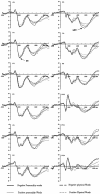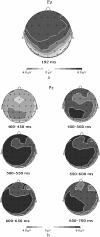ERP differences between processing of physical characteristics and personality attributes
- PMID: 22967478
- PMCID: PMC3584804
- DOI: 10.1186/1744-9081-8-49
ERP differences between processing of physical characteristics and personality attributes
Abstract
Background: Limited data from behavioral and brain-imaging studies indicate that personality traits and physical characteristics are processed differently by the brain. Additionally, electrophysiological results of studies comparing the processing of positive and negative words have produced mixed results. It is therefore not clear how physical and personality attributes with emotional valence (i.e., positive and negative valence) are processed. Thus, this study aimed to examine the neural activity associated with words describing personality traits and physical characteristics with positive or negative emotional valence using Event Related Potentials (ERPs).
Methods: A sample of 15 healthy adults (7 men, 8 women) participated in a computerized word categorization task. Participants were asked to categorize visual word stimuli as physical characteristics or personality traits, while ERPs were recorded synchronously.
Results: Behavioral reaction times to negative physical stimuli were shorter compared to negative personality words, however reaction times did not significantly differ for positive stimuli. Electrophysiological results showed that personality stimuli elicited larger P2 and LPC (Late Positive Component) amplitudes compared to physical stimuli, regardless of negative or positive valence. Moreover, negative as compared with positive stimuli elicited larger P2 and LPC amplitudes.
Conclusion: Personality and physical stimuli were processed differently regardless of positive or negative valence. These findings suggest that personality traits and physical characteristics are differentially classified and are associated with different motivational significance.
Figures



Similar articles
-
Effects of valence and arousal on emotional word processing are modulated by concreteness: Behavioral and ERP evidence from a lexical decision task.Int J Psychophysiol. 2016 Dec;110:231-242. doi: 10.1016/j.ijpsycho.2016.07.499. Epub 2016 Jul 16. Int J Psychophysiol. 2016. PMID: 27432482
-
Effects of facial attractiveness on personality stimuli in an implicit priming task: an ERP study.Neurol Res. 2016 Aug;38(8):685-91. doi: 10.1080/01616412.2016.1190538. Epub 2016 Jun 8. Neurol Res. 2016. PMID: 27268219
-
Are we sensitive to valence differences in emotionally negative stimuli? Electrophysiological evidence from an ERP study.Neuropsychologia. 2007 Sep 20;45(12):2764-71. doi: 10.1016/j.neuropsychologia.2007.04.018. Epub 2007 Apr 27. Neuropsychologia. 2007. PMID: 17548095 Clinical Trial.
-
Effects of valence and arousal on affective priming vary with the degree of affective experience denoted by words.Int J Psychophysiol. 2019 Jun;140:15-25. doi: 10.1016/j.ijpsycho.2019.03.011. Epub 2019 Apr 5. Int J Psychophysiol. 2019. PMID: 30959075
-
High arousal words influence subsequent processing of neutral information: evidence from event-related potentials.Int J Psychophysiol. 2012 Nov;86(2):143-51. doi: 10.1016/j.ijpsycho.2012.06.001. Epub 2012 Jun 10. Int J Psychophysiol. 2012. PMID: 22691441
Cited by
-
Neural correlates of self-appraisals in the near and distant future: an event-related potential study.PLoS One. 2013 Dec 20;8(12):e84332. doi: 10.1371/journal.pone.0084332. eCollection 2013. PLoS One. 2013. PMID: 24376803 Free PMC article.
-
Neural correlates of chemotherapy-induced emotion regulation impairment in breast cancer patients.Am J Cancer Res. 2019 Jan 1;9(1):171-179. eCollection 2019. Am J Cancer Res. 2019. PMID: 30755820 Free PMC article.
References
-
- Pascale D, Sabine P, De Bosscher S, Véronique-Léoni V. Effects of facial attractiveness, gender, and competence of applicants on job recruitment. Swiss J Psychol. 2009;68:33–42. doi: 10.1024/1421-0185.68.1.33. - DOI
-
- Olivola C, Todorov A. Fooled by first impressions? Reexamining the diagnostic value of appearance-based inferences. J Exp Soc Psychol. 2010;46:315–324. doi: 10.1016/j.jesp.2009.12.002. - DOI
Publication types
MeSH terms
LinkOut - more resources
Full Text Sources

